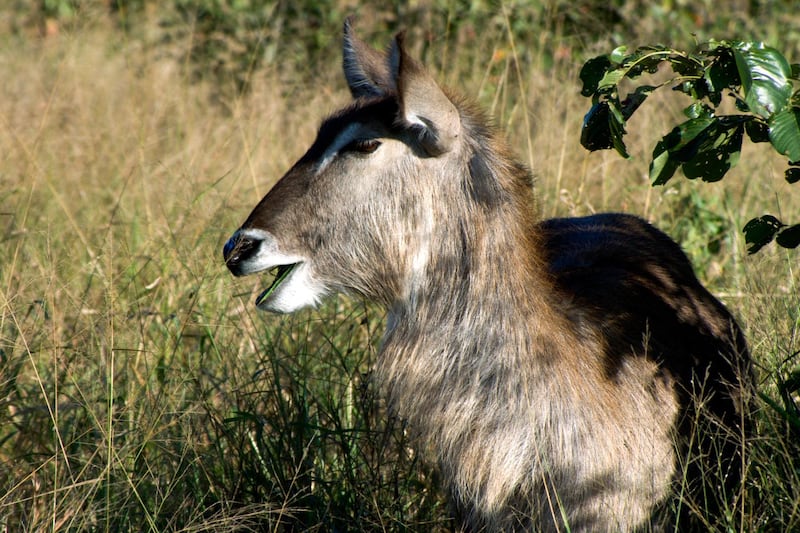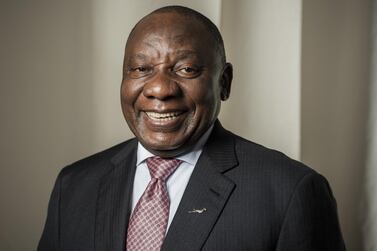Animal carcasses have become a depressing but familiar sight at Thuru Lodge, a wildlife ranch in the dusty Northern Cape province, which draws visitors to see its herds of giraffe and antelope.
“We’ve had very little rain in the past seven years,” says Burger Schoeman, manager at the lodge, which depends on tourism. “The rainfall of the past five years in total is 250 millimetres — the same amount we normally would get in a year.”
The lodge has lost around 1,000 animals of its usual stock of around 4,500. Thuru attracts tourists who come for game drives — trips around the farm in an open top vehicle, as well as licensed hunters.
Lack of rain means very little vegetation and animals slowly succumb to thirst and starvation. “We drive tourists around and come across dead animals — this is not nice for visitors to see,” Mr Schoeman says.
Wildlife ranching is big business throughout southern Africa. The creatures that are most commonly associated with Africa — lions, elephants, rhinos and others — draw tourists from around the world. State wildlife reserves such as the Kruger Park that are the size of Belgium span borders and are home to vast herds.
Private ranches also proliferate, with more and more farmers abandoning cattle and crop raising. Instead, many are purchasing wild animals and investing in luxury guest facilities. South Africa in particular, which legalised the private ownership of wild animals in 1992, has seen a rapid growth in game farming.
“This is one of the only industries in which South Africa has a comparative advantage over the rest of the world,” says Tebogo Mogashoa, president of Wildlife Ranching South Africa (WRSA). Private ranches have gone from almost none 30 years ago to 10,000, and these now account for just more than 15 per cent of the country’s land mass, according to figures supplied by the environment ministry.
Altogether, ecotourism brings in almost $1 billion (Dh3.67bn) into the country per year, government figures show. The revenue is sorely needed as South Africa attempts to hang onto its investment grade rating for its sovereign debt with Moody's. The other two major ratings agencies, Fitch Ratings and S&P Global, have already downgraded the country's issuer rating to junk status.
“In the long term, it’s a good, stable cash flow business if managed correctly,” Mr Mogashoa says, who himself has a game ranch about 300 kilometres north of Johannesburg.
However, the region is once again in the grip of a drought that threatens humans and animals alike. It is mostly the impact on humans that gets attention, such as when Cape Town very nearly became the first city in modern times to run out of water two years ago.
Although nick-of-time rains spared the city from going dry, the country — and those surrounding it such as Namibia, Botswana and Zimbabwe — remain desperate for rain.
Entire populations of animals are now at risk and drought is a threat to large sections of the game farm industry. In the Northern Cape alone, more than two-thirds of the wildlife has died, according to WRSA.
While water for drinking can be secured through borehole drilling, it is not enough to make up for the shortage of rain needed to grow fodder. The cost of trucking animal feed over hundreds of kilometres is something that most farmers cannot afford.
“This is very worrying,” says Wandile Sihlobo, chief economist of the Agricultural Business Chamber of South Africa (Agbiz). He says farmers cannot afford to indefinitely supply feed to their stocks, and that the authorities should provide assistance.
“The quickest thing that can be done is the supplying of feed to farmers. We understand the national government’s finances are constrained, so it is up to provincial governments to reallocate some of their resources to assist farmers.”
The government has consequently pledged 300 million South African rand (Dh75.6m) in drought aid to the region.
The value of wild game goes beyond just tourism. Rather, trade in wildlife has also become an industry in its own right. Regular auctions of prize stock animals are held, including lions, rhinos, ostriches, buffalo and many more.
The president of the country Cyril Ramaphosa is himself a keen animal collector and suffers under the nickname critics gave him of ‘buffalo man,’ after reportedly spending more than a million dollars on a bull.
Neil Dodds, chairman of the Summit Group industrial conglomerate that holds regular game auctions, says the company’s last sale was ‘tough’ but went reasonably well, having knocked down almost 8 million rand in sales. “To get that amount of money out in current conditions with the drought and tough conditions was a pleasant surprise.”
Many potential buyers are staying away, though, because they are waiting for the rains to return. “Everybody is saying, they’d love to buy, but just cannot afford another mouth to feed on their farms.”
Perhaps the most lucrative aspect of game ranching is hunting; hunters spend nearly 14 billion rand a year, according to research headed up by Peet van der Merwe, professor of tourism at North-West University. It is hunting that keeps the game industry alive, supporting farmers and auctioneers alike.
“These private reserves rely heavily on hunting to keep their businesses going and hunters need game to hunt,” he says. “Therefore, private reserve owners often need to breed game for this purpose.”
Hunting, of course, has become a red-hot subject of controversy. Images of wealthy westerners posing over the body of an animal — such as the killing of Cecil the lion in Zimbabwe a few years ago — generate fierce online debate.
While acknowledging this, Mr van der Merwe says hunters spend twice as much as conventional safari tourists.
“Our calculations also show that between 70 per cent and 80 per cent of trophy hunters’ spending takes place in the area of the hunt. This includes the accommodation, game hunted and in some cases also the trophy handling and processing.
Around 7,600 foreign trophy hunters visit the country each year, but it is the nearly 60,000 local sport hunters who form the backbone of the industry. These hunts are for meat, especially to be turned into biltong, a local dried venison seasoned with herbs and spices.
Much of the biltong hunting takes place in deep rural southern Africa, where few other forms of income for locals exist. As hunting grows, so do jobs on lodges that need guides, chefs, managers and maintenance crews.
Mr van der Merwe notes that species once considered on the brink of extinction such as the tsessebe, roan antelope, sable, bontebok and rhino, now thrive on private wildlife reserves; “Hunting, therefore, remains very relevant to South Africa, and southern Africa.”
For now, game ranchers will be hoping for rain to sweep away the drought and restore their land. There may be some hope. The same winds that brought relieving rains to fire-ravaged Australia also appear to have reached the southern edge of Africa.
“Hopefully we are at the end of the drought,” says Mr Schoeman of Thuru Lodge. “It’s been a long struggle for years — we really need the rain.”







